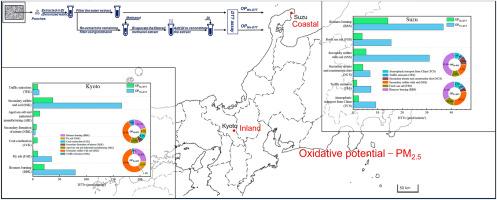Source apportionment of PM2.5 and its oxidative potential in inland and coastal areas in Japan using positive matrix factorization with composite extraction
IF 3.7
2区 环境科学与生态学
Q2 ENVIRONMENTAL SCIENCES
引用次数: 0
Abstract
Fine particulate matter with a diameter ≤2.5 μm (PM2.5) can penetrate the respiratory system and generate reactive oxygen species (ROS), posing a threat to human health. The ability to generate ROS can be represented by the oxidative potential (OP) of PM2.5 in air. Herein, PM2.5 was collected from Kyoto and Suzu, Japan, which are downwind regions in East Asia. Kyoto represents a typical densely populated urban center situated in one of Japan's plains, and Suzu is a remote coastal town. This pairing provides a representative framework for assessing OP-related health risks across different environmental settings in Japan. Composite extraction using water and methanol as solvents was used to extract the chemical components of samples, and the OP values of their water-soluble (OPWs-DTT) and methanol-soluble (OPMs-DTT) fractions were assessed via dithiothreitol (DTT) assay. The daily average of the total DTT consumption rate (OPWs-DTT + OPMs-DTT) was 436.8 ± 249.7 pmol/min/m3 in Kyoto and 141.0 ± 54.0 pmol/min/m3 in Suzu. The OPMs-DTT/OPWs-DTT ratio exceeded 30 % in both locations, indicating that methanol could effectively complement water in estimating the OP of PM2.5. Positive matrix factorization analysis revealed seven pollution sources in Kyoto and six in Suzu. Biomass burning and secondary sulfate with soil were the main OP contributors in both locations. Kyoto (inland) and Suzu (coastal) were both influenced by marine aerosols. Additionally, transboundary pollution from northeast Asia was observed in Suzu. These results highlight significant differences in the OP-relevant PM2.5 sources between locations and the variable, non-negligible contribution of water-insoluble components.

基于复合提取正矩阵分解的日本内陆和沿海地区PM2.5及其氧化电位源解析
直径≤2.5 μm (PM2.5)的细颗粒物可以穿透呼吸系统,产生活性氧(ROS),对人体健康构成威胁。产生ROS的能力可以用空气中PM2.5的氧化电位(OP)来表示。本文的PM2.5采集地点为日本京都和苏州,这两个地区均为东亚顺风区。京都是一个典型的人口稠密的城市中心,位于日本的平原之一,而苏州是一个偏远的沿海城镇。这种配对提供了一个有代表性的框架,用于评估日本不同环境背景下与口服毒物有关的健康风险。采用水和甲醇为溶剂的复合萃取法提取样品的化学成分,采用二硫代苏糖醇(DTT)法测定其水溶性组分(OPWs-DTT)和甲醇可溶性组分(OPMs-DTT)的OP值。总DTT消耗率(OPWs-DTT + OPMs-DTT)日平均值京都为436.8±249.7 pmol/min/m3,苏州为141.0±54.0 pmol/min/m3。两个地点的OPMs-DTT/OPWs-DTT比值均超过30%,说明甲醇可以有效补充水估算PM2.5的OP。正矩阵分解分析显示京都有7个污染源,苏州有6个污染源。在这两个地点,生物质燃烧和次生硫酸盐与土壤是主要的OP贡献者。京都(内陆)和苏州(沿海)都受到海洋气溶胶的影响。此外,苏州市还监测到来自东北亚的跨界污染。这些结果突出了不同地点与op相关的PM2.5源的显著差异,以及水不溶性组分的可变贡献,不可忽略。
本文章由计算机程序翻译,如有差异,请以英文原文为准。
求助全文
约1分钟内获得全文
求助全文
来源期刊

Atmospheric Environment
环境科学-环境科学
CiteScore
9.40
自引率
8.00%
发文量
458
审稿时长
53 days
期刊介绍:
Atmospheric Environment has an open access mirror journal Atmospheric Environment: X, sharing the same aims and scope, editorial team, submission system and rigorous peer review.
Atmospheric Environment is the international journal for scientists in different disciplines related to atmospheric composition and its impacts. The journal publishes scientific articles with atmospheric relevance of emissions and depositions of gaseous and particulate compounds, chemical processes and physical effects in the atmosphere, as well as impacts of the changing atmospheric composition on human health, air quality, climate change, and ecosystems.
 求助内容:
求助内容: 应助结果提醒方式:
应助结果提醒方式:


